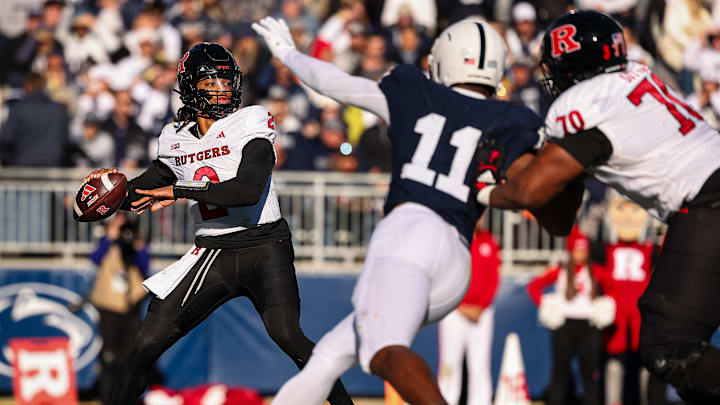Penn State is the undisputed Linebacker U in college football, and even more sacred than LBU is St1x C1ty. When Abdul Carter got to Happy Valley as a four-star out of Philadelphia in the Class of 2022, he put on the legendary No. 11, worn by LaVar Arrington, NaVorro Bowman, Brandon Bell, and Micah Parsons. The expectation was that he’d be a superstar and that he’d be a linebacker as Arrington, Bowman, Bell, and Parsons all were.
For his first two seasons, he did play linebacker, but even after another All-Big Ten season in 2023, it became undeniable that he, like Parsons, was playing the wrong position at Penn State. When Parsons was selected 12th in the 2021 NFL Draft by the Dallas Cowboys, his new team immediately transitioned him from off-ball linebacker to edge rusher and now he’s coming off his third straight season with 13+ sacks in the NFL.
Parsons slipped out of the top 10 in that draft because he was primarily a linebacker. Carter is undergoing that transition a year early to help his draft stock improve ahead of the 2025 draft by playing a position that is considered more valuable.
According to Spotrac, in 2024, NFL teams spent a total of 1,000,833,582 salary cap dollars on 199 total edge rushers. At linebacker, they spent just 836,827,219 cap dollars on linebackers. That number even includes certain outside linebackers like T.J. Watt and Khalil Mack, who can easily be considered edge rushers instead and account for over $30 million on their team’s salary cap.
The highest-paid off-ball linebacker in the NFL is Fred Warner, who in 2021 signed a five-year $95.225 million contract. By cap dollars, he is the 13th highest-paid defensive player in football, with six edge rushers ahead of him.
Carter greatly improves his earning potential with this move, but the good news is that the decision is far from a selfish one.
Abdul Carter will immediately be Penn State’s best edge rusher, a position that isn’t just perceived as more valuable by the NFL, but actually is on gameday. The crazy thing is, he already was the team’s best pass rusher even with Robinson and Isaac on the roster last year.
Whoever facilitated the move, whether it was Carter, James Franklin, new defensive coordinator Tom Allen, or some mysterious agent in Carter’s corner who would benefit from a boost in his rookie salary in 2025, it’s best for all parties involved.
Last season in college football, according to Pro Football Focus, there were 1,001 players who had 100 or more snaps as a pass rusher, and Abdul Carter’s pass rush win rate of 24.8% in his 112 snaps as a pass rusher, ranked third only behind Ben Bell of Texas State and projected 2024 first-round pick Laiatu Latu from UCLA.
As a primary off-ball linebacker, who only occasionally took reps with the defensive linemen at practice, Carter was arguably the third most efficient pass rusher in the country. His 28 total pressures ranked third on Penn State’s No. 1 ranked defense behind Adisa Isaac (33) and Dani Dennis-Sutton (30) who both had over 200 pass rush snaps and Carter’s 4.5 sacks were tied for second.
Now, among that group of 1,001, Carter ranked 990th in terms of rush percentage on true pass sets. That simply means the percentage of passing snaps that the player was on the field for and went after the passer. Carter came in at 42.5% and only lined up on the defensive line for 94 of his 588 snaps last year, while he dropped in coverage 288 times.
He will need to undergo a complete transformation in play style, but it won’t just highlight his strengths, it’ll help eliminate his biggest weaknesses, which are essentially just playing linebacker.
Last year, Carter missed 16 tackles, by far the most on the team. His open-field tackling was a problem against the run and against the pass where he allowed 100 yards after the catch on just 16 receptions in coverage. Receivers averaged 10.8 yards per reception against Carter and caught 76.2% of the targets with him in coverage. So, if he misses tackles and can’t cover, then the only question is what the hell took his coaching staff so long?
As a linebacker Carter lived on splash plays, slicing into the backfield like Arrington and Bowman once did, but he lacked the consistency to thrive at the position in the NFL. Now, he’ll be utilizing his most unique skill set on nearly every play.
James Franklin and Abdul Carter could have been swept up in the nostalgic whirlwind of LBU and St1x C1ty. They could have let stubbornness or a lack of trust in a young linebacker group force Carter to play his junior season at linebacker, where he would likely be All-Big Ten again and maybe even an All-American.
LaVar Arrington became a legend when he leaped over Illinois’s offensive line in 1998. Now, Carter’s taking a leap of his own.
A leap of faith with a position change one year away from the biggest payday of his life. But it’s one that I believe will give Penn State the most dominant edge-rusher in college football next season and will turn Carter into a top-10 NFL draft pick 14 months from now.
